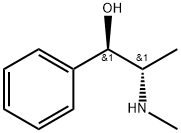에페드린 C화학적 특성, 용도, 생산
화학적 성질
white crystals or powder
용도
Ephedrine, 1-phenyl-2-methylaminopropanol, C6H5 CH(OH)CH(NHCH3)CH3, is a white-to-colorless granular substance, unctuous (greasy) to the touch, and hygroscopic. The compound gradually decomposes upon exposure to light. Soluble in water, alcohol, ether, chloroform, and oils, and decomposes above this temperature. Ephedrine is isolated from stems or leaves of Ephedra, especially Ma huang (found in China and India). Medically, it is usually offered as the hydrochloride. In the treatment of bronchial asthma, ephedrine is known as a beta agonist. Compounds of this type reduce obstruction by activating the enzyme adenylate cyclase. This increases intracellular concentrations of cAMP (cyclic 3 5 -adenosine monophosphate) in bronchial smooth muscle and mast cells. Ephedrine is most useful for the treatment of mild asthma. In severe asthma, ephedrine rarely maintains completely normal airway dynamics over long periods. Ephedrine also has been used in the treatment of cerebral transient ischemic attacks, particularly with patients with vertabrobasilar artery insufficiency who have symptoms associated with relatively low blood pressure, or with postural changes in blood pressure. Ephedrine sulfate also has been used in drug therapy in connection with urticaria (hives).
정의
ephedrine: An alkaloid,C
6H
5CH(OH)CH(CH
3)NHCH
3 found inplants of the genus Ephedra, onceused as a bronchodilator in the treatmentof asthma. It is also used as astimulant and appetite suppressant.Structurally, it is a phenylethylamineand is similar to amphetamines, althoughless active. It is, however,widely used in the illegal synthesis ofmethamphetamine. The moleculehas two chiral centres. If the stereo- chemical conformations are opposite(i.e. 1R,2S or 1S,1R) the nameephedrine is used. If the conformationsare the same (1R,2R or 1S,2S)then the compound is called pseudoephedrine.
Biological Functions
Ephedrine is a naturally occurring alkaloid that can cross
the blood-brain barrier and thus exert a strong CNS-stimulating
effect in addition to its peripheral actions.The latter
effects are primarily due to its indirect actions and depend
largely on the release of norepinephrine. However,
ephedrine may cause some direct receptor stimulation,
particularly in its bronchodilating effects. Because it resists
metabolism by both COMT and MAO, its duration
of action is longer than that of norepinephrine. As is the
case with all indirectly acting adrenomimetic amines, ephedrine is much less potent than norepinephrine; in
addition, tachyphylaxis develops to its peripheral actions.
Unlike epinephrine or norepinephrine, however, ephedrine
is effective when administered orally.
위험도
Toxic by ingestion.
Mechanism of action
Ephedrine is a naturally occurring sympathomimetic amine that possesses
both direct (agonist at α- and β-receptors) and indirect activity via its
potentiation of noradrenaline release from sympathetic nerve terminals. It
causes an increase in HR, contractility, CO and arterial pressure (systolic >
diastolic). Bronchodilation occurs via a β2-mediated mechanism, and it is
occasionally used for this purpose. Its duration of action is longer than
endogenous catecholamines as it is not metabolised by COMT or MAO.
Tachyphylaxis can occur as a result of depletion of noradrenaline from nerve
terminals and persistent occupation of adrenergic receptors. Ephedrine
crosses the placenta and can increase fetal metabolic rate with a subsequent
metabolic acidosis. It is usually administered by i.v. bolus at a dose of 3–
9 mg.
Pharmacology
Ephedrine increases systolic and diastolic blood
pressure; heart rate is generally not increased.
Contractile force of the heart and cardiac output are
both increased. Ephedrine produces bronchial smooth
muscle relaxation of prolonged duration when administered
orally. Aside from pupillary dilation, ephedrine
has little effect on the eye.
Clinical Use
Ephedrine is useful in relieving bronchoconstriction
and mucosal congestion associated with bronchial
asthma, asthmatic bronchitis, chronic bronchitis, and
bronchial spasms. It is often used prophylactically to
prevent asthmatic attacks and is used as a nasal decongestant,
as a mydriatic, and in certain allergic disorders.
Although its bronchodilator action is weaker than that
of isoproterenol, its oral effectiveness and prolonged
duration of action make it valuable in the treatment of
these conditions. Because of their oral effectiveness and
greater bronchiolar selectivity, terbutaline and albuterol
are replacing ephedrine for bronchodilation.
부작용
Symptoms of overdose are related primarily to cardiac
and CNS effects. Tachycardia, premature systoles, insomnia, nervousness, nausea, vomiting, and emotional
disturbances may develop. Ephedrine should not be
used in patients with cardiac disease, hypertension, or
hyperthyroidism.
Safety Profile
A human poison by an
unspecified route. An experimental poison
by intravenous, subcutaneous,
intramuscular, and intraperitoneal routes.
Moderately toxic by ingestion and parented
routes. Causes rapid pulse, rise in blood
pressure, and other actions similar to
epinephrine. An experimental teratogen.
Used in production of drugs of abuse. Has
been known to cause allergic sensitization.
When heated to decomposition it emits
toxic fumes of NOx.
Purification Methods
Purify (-)-ephedrine by vacuum distillation (dehydrates) and forms waxy crystals or granules, and may pick up 0.5 H2O. The presence of H2O raises its melting point to 40o. [Moore & Taber J Amer Pharm Soc 24 211 1935.] The anhydrous base crystallises from dry ether [Fleming & Saunders J Chem Soc 4150 1955]. It gradually decomposes on exposure to light and is best stored in an inert atmosphere in the dark (preferably at -20o). Its solubility in H2O is 5%, in EtOH it is 1% and it is soluble in CHCl3, Et2O and mineral oils. It has pKa values in H2O of 10.25 (0o) and 8.69 (60o) [Everett & Hyne J Chem Soc 1136 1958, Prelog & H.flinger Helv Chim Acta 33 2021 1950] and pK a 8.84 in 80% aqueous methoxyethanol [Simon Helv Chim Acta 41 1835 1958]. The hydrochloride has m 220o (from EtOH/Et2O) and [] D20 -38.8o (c 2, EtOH). [IR: Chatten & Levi Anal Chem 31 1581 1959.] The anhydrous base crystallises from Et2O [Fleming & Saunders J Chem Soc 4150 1955]. [Beilstein 13 H 373, 13, III 1720, 13 IV 1879.]
에페드린 준비 용품 및 원자재
원자재
준비 용품








